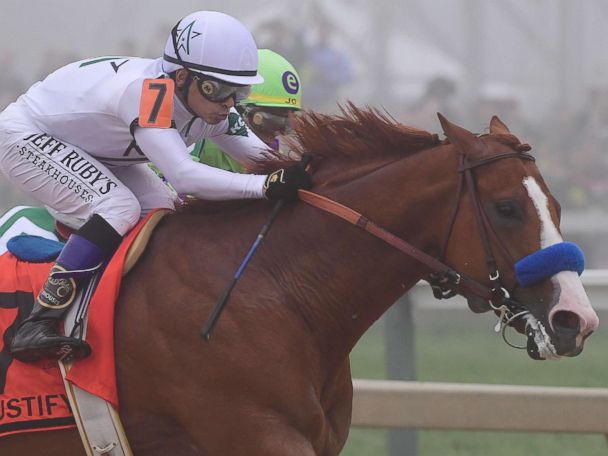What to look for in a racehorse’s conformation.
Triple Crown Winners Past winners of the Kentucky Derby, Preakness, Belmont Stakes. If you care anything about horse racing, you must have seen the Belmont Stakes (G1) unless something else. Triple Crown, in American horse racing, championship attributed to a three-year-old Thoroughbred that in a single season wins the Kentucky Derby, the Preakness Stakes, and the Belmont Stakes. Jun 04, 2012 Carlos Torres June 4, 2012 Only 11 horses in the 137 years of the Triple Crown have captured horse racing's greatest achievement, sweeping the Kentucky Derby, the Preakness Stakes and the Belmont.
What is Horse Conformation?

Conformation is the physical appearance of an animal due to the arrangement of muscle, bone and other body tissue. It is the sum of these body parts and how they blend together which determines the acceptability or unacceptability of the horse’s conformation. Good conformation is the overall blending of body parts to form a beautiful athlete.

No horse is conformed perfectly. Remember that in examining horses the purpose is to exclude those with physical faults you consider unacceptable.
Overall, when examining a horse you should consider balance, bone, intelligence and athleticism.
Balance – Is the horse well-proportioned? Does the frame suit its muscle?
Bone – Does it appear to be substantial – not too light?
Intelligence – Does the horse seem in control, aware of its surroundings, alert?
Athleticism – Does the horse look physically fit and capable?
Remember, every horse has some fault with regard to pedigree and conformation. The art or science of evaluating a horse is deciding which of those faults are less likely to adversely impact the intended use of the animal. It is helpful to know something about the pedigree of the horse as it may relate to a particular horse’s conformation. Some sires pass similar conformational faults to offspring, with some of the faults having little or no consequence with respect to their racing success.
Everyone has different thresholds with regard to what constitutes acceptable faults. Establish your own thresholds, but be realistic considering your budget.
Conformation Essentials: Side View
Feet – A horse’s hooves must be able to withstand a great deal of pressure. At full speed, a 500kg thoroughbred will place the equivalent of 100 times the force of gravity on each hoof with every stride, so it is essential that the foot be shaped properly to withstand this concussion and to dissipate the shock of impact. Consider the proportion, substance and size of the hoof. The underside of the hoof should have a round, slightly oval shape, with some depth.
Pasterns – The pastern should be at a 45-degree angle (example A; example B shows a too-sloping pastern; example C shows a too-upright pastern). Its length should be proportionate; too long a pastern could indicate weakness and tendon strain, while if too short it may absorb too much concussion, thus stressing the bone structure.
Cannon bones – Ideally, the cannon bone should be short, strong, and have mass. The cannon bone bears the most weight of any bone in a horse’s body. The bone should exit the lower knee or hock cleanly and be well-centred.
Knee – Bones in and leading to the knee should line up in a balanced manner; not tilting forward (“over at the knee” or “buck-kneed”) or back (“back at the knee” or “calf-kneed”), nor severely offset to one side or the other.
Shoulder – The shoulder should have the same slope or angle as the pastern (see diagram below). The ideal slope of the shoulder is approximately 45 to 50 degrees. In general, the angle of the pastern will correspond with the angle of the shoulder. Stride length is largely determined by the conformation of the shoulder. The straighter the shoulder, the shorter the stride. Also, a straight shoulder absorbs concussion instead of dispensing it and will put stress on the bones of the leg and shoulder.
Neck – A horse’s neck should be sufficient in scope to provide adequate wind for the horse and be well tied in at the withers. A horse with a well-muscled, well-proportioned neck has a longer, more rhythmic stride and can more easily maintain its balance when running. An easy, rhythmic stride will cause less fatigue while racing. Fatigue can decrease the performance and increase the chances of injury. In short, does the neck fit the rest of the body?
Head – The head should be broad enough to permit adequate air passage. Generally, the width at the back of the jaw should be about the size of a fist. Nostrils should be of adequate size. People refer to an “attractive” head. That usually means the head is short, with well-set ears; has large bold eyes, a short distance from eye to muzzle, large nostrils and a refined muzzle with a shallow mouth. In general, there is no physiological benefit to the horse having an “attractive” head. An “ugly” head functions similarly to an attractive head.
Eye – The eyes should be big and bright. Look for an intelligent, keen eye. A horse with a lot of white around the eye is often nervous and flighty.
Back – The distance from the withers to top of croup or hips should match the length of the horse’s neck from the poll to the withers. The length of the back is directly related to the slope of shoulder. The steeper the shoulder, the longer the back. A horse with a long back is usually not as well balanced as a short-backed horse.
Hips/Rump – The croup or hip should have a gentle slope; not too steep or flat – and good width. The gaskins should depict strength and should complement the muscles of the rump.
Hocks – A Bloodstock horse’s hocks should not be straight as a post, nor curved so deeply as to be “sickle-hocked,” but somewhere in between. Ideally, if you dropped an imaginary line from the point of the buttocks to the ground, it should run parallel to the cannon bone and be slightly behind the heel.
Conformation Essentials: Front & Rear View
Feet – Look for balanced feet on both sides, or symmetry. Avoid misshaped, dished or badly cracked feet.
Cannon bones – From the front, the cannon bones should appear straight and be of the same length. Keep an eye out for splints under the knee, on the front of the cannon bones. Example (A) shows a bow-legged horse, example (B) a knock-kneed horse, and example (C) shows offset or bench knees.
Knees – It is best if the knees are set squarely on top of the cannon bones, not off to one side or another: “Offset knees.”
Chest – A horse’s chest should be broad and appear powerful. Narrow chested or slab-sided horses are said to lack power.
See All Results For This Question

Shoulder – Look for balance, symmetry and good muscling. A straight line from the point of the shoulder should bisect the entire front leg all the way to the toe. Also, the width of the toes on the ground should be the same width as their origin in the chest.
Hocks – From the rear, the hocks should appear to point straight at you and not turn in – “cow hocks” or turn out – “open in the hocks” or “bow-legged.” Ideally, an imaginary line from the point of the buttocks to the ground should bisect the gaskin, hock and hoof.
Triple Crown Winners Horse Racing Uk
Hip/Buttocks – Note that much of the horse’s athleticism and power comes from behind. Definition and development are key attributes.
Conformation Essentials: Walking Stride
Front/Rear view – The horse should move straight toward and away from you. Observe whether the horse toes-in or toes-out as it walks. In example A, a horse whose legs and feet are aligned properly will stride straight ahead. In example B, a horse who toes out will have a tendency to “wing in,” increasing the likelihood that the swinging leg will strike the supporting leg during the stride. In example C, a horse who toes in has a tendency to “wing out” or “paddle, increasing stress on the outside of the limbs.
Side view – Check for the overstep, meaning do the hind feet reach beyond the front hoof prints? Observe the horse’s head. Be certain it does not bob unusually when walking, as this may indicate soreness or lameness.
Walk – Look for a smooth, long stride. Avoid horses that walk “wide” in front.
Find the perfect conformation and start racing!
American Pharoah
Once you’ve found the perfect horse like our stable stars, it’s time to get training so you can join us in the Everest race. If you have any questions relating to horse conformation or anything else, please don’t hesitate to send us a message. The team at Triple Crown are always happy to help.
